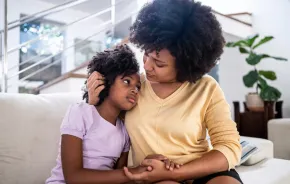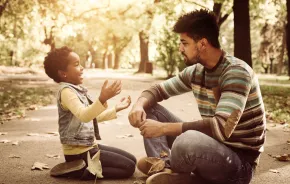
I have always paid attention to clothes. I follow fashion as an admiring fan, and attire myself accordingly on a diet of mostly well-made, distinct and durable items purchased at consignment stores. And, for better or worse, I’ve raised a child who also is a clotheshorse. That means finding kid-friendly threads that are both fashionable and affordable.
What I’ve not always considered as closely is where our new clothes come from. So many of us are intentional about where we shop for food, specifically choosing organic and locally sourced ingredients when grocery shopping. What if we gave the same consideration to how we clothe our families?
“Whether cotton, wool, alpaca or leather, the same sustainability issues that we think about in our kitchen are relevant in our closet,” says Nadine Farag, a New York City–based writer and sustainability consultant. “In 2010, the fashion industry produced over 150 billion pieces of clothing. That’s a shocking figure when you consider the natural resources, including water and land, required to produce these clothes.”
And clothing requires a lot, often polluting the environment along the way. Tanning, product manufacturing and dyeing are three of the top 10 most polluting industries globally, according to international antipollution organization Pure Earth. “Because of the combination of environmental pollution from both farms and factories, fashion is today one of the most polluting industries in the world,” adds Farag.
Not only that, fashion can have terrible consequences for the mothers and children who so often make what we wear. Retail labor often exposes them to sexual harassment, unequal pay and unsafe working conditions. One national report of the United States’ low-wage industry, much of which involves retail, found that women were significantly more likely than men to experience minimum-wage violations. That adds up, sometimes to as much as 15 percent in lost annual income.
“This,” says Farag, “is an industry that mainly employs mothers and dramatically affects children and their well-being.”
I’ll be the first to admit how easy it is to ignore fashion’s footprint. We’re bombarded with advertisements of the charmed life of well-dressed models, distracted by the lure of sales at chain stores and ever conscious of our precious time and thus the importance of convenience.
But if you take a step back and assess what kind of consumer you want to be and what you want to teach your kids, conscientious and affordable clothes shopping can be done. Here’s how to get started when dressing your kid cheaply, chicly and sustainably.
Before you shop, take stock
“So much of what is unsustainable about fashion these days is that we’re buying too much,” says Farag. “If you look through your kid’s closet and find clothes they’ve never worn or worn only a handful of times, this might be a sign that you’re buying too much.”
Think about long-term wear, reuse and upcycling. “Certain things are going to happen to kids’ clothes. They’re going to get stained with chocolate milk. They’re going to get ripped in the knees,” says Natalie Holbrook, former lifestyle blogger and author of parenting and fashion memoir Hey Natalie Jean. “When I shop for my son, I shop for basics that will look equally as good when trashed as they do when new. I spend extra on good denim pants that will wear well and look good as high-waters.”
Also include your kid in any decision before purchasing something new. “My kids have seriously strong preferences,” says Shana Draugelis, founder of popular blog The Mom Edit and mother to two school-age boys. “Self-expression through style is totally OK in my book, and I nurture theirs as best I can.”
Draugelis browses online to create wardrobe collections for her sons. She takes screenshots of 5–10 items and then lets her kids choose before she makes any purchases. Not only does that save time and money, it means fewer clothes bought that’ll never be worn.
Use secondhand for as long as you can
“I love buying really high-end used clothing for my kids,” says Draugelis. “[Those pieces] tend to stand the test of time.”
Retail consignment websites such as ThredUp and Schoola are selective about what they resell, so the clothing and shoes on their sites are often very wearable, “like new” and, in some cases, still have tags attached.
“You see the most selection for babies and young kids, who grow like weeds,” says Turi Fesler Steffen, Schoola’s director of social media and blog. “Infants change size every few months, so it really doesn’t make sense to buy new.”
Consignment shopping can be more challenging for older kids, especially boys. “High-quality used pants for boys? They don’t exist,” says Draugelis. “Boys seem to trash every single pair of pants they touch.”
But don’t give up. Rather, shop retailers who have done the curating for you, whether online or in person. Sometimes you can even play stylist yourself. “On Schoola, you can create a custom collection for each of your kids, so when you’re ready to shop, you are only browsing in your kid’s size,” says Fesler Steffen. “If you’re worried about sizing, shop brands you’re familiar with or Google the brands to look at their sizing charts.”
If you prefer to shop in person, Seattle- and Bellevue-area children’s consignment shops such as Kookaburra Kids, Childish Things, Sela’s Small Couture, Hopscotch, and Sugarlump offer high-quality, stylish clothes. Their selections can be small, but the finds are worth the time and effort.
Plus, there’s one huge advantage of shopping consignment: selling consignment. It’s an easy way to earn credit toward your child’s wardrobe. The same websites and local stores mentioned above also accept consigned clothing from customers (check their respective websites for details). A good rule of thumb from Fesler Steffen: “If you paid more than $15 retail for it, try to consign it.”
When you buy new, consider this
Despite its merits, secondhand is neither a solution to make fashion sustainable nor a remedy for all of your child’s clothing needs.
“In order to bring about change in the fashion industry, we need to support the companies that are making fashion responsibly,” says Farag. “It’s great to balance secondhand with buying from brands who work really hard to manufacture their clothing consciously.”
To find retailers who produce high-quality clothing and are transparent about production and material sourcing, read the label.
“You’re looking for two things: what material the clothing is made from and where it’s made,” says Farag. Look for clothing made from plant fibers, ideally organic. These are more sustainable than polyester, which is made from crude oil.
The item’s country of origin also indicates the environmental and labor standards that went into production. “Buying clothes made in a developed country helps,” says Farag. “Labor, workplace health and safety standards are typically higher and more enforceable than in developing countries.”
Get creative in shopping from local or U.S. producers and vendors: Find good sources for basics. Draugelis recommends mother-owned business Nonchalant Mom for organic cotton, American-made items for kids and moms.
“Your best bet for sustainably produced clothing is to support independent labels, like those on Etsy,” says Farag.
Ultimately, make sure your kid likes whatever you buy so he’ll wear it. “I find myself asking [my son], ‘Are you sure you want this bright orange T-shirt?’” says Holbrook. “He’s usually pretty sure. A kid likes what he likes!”











